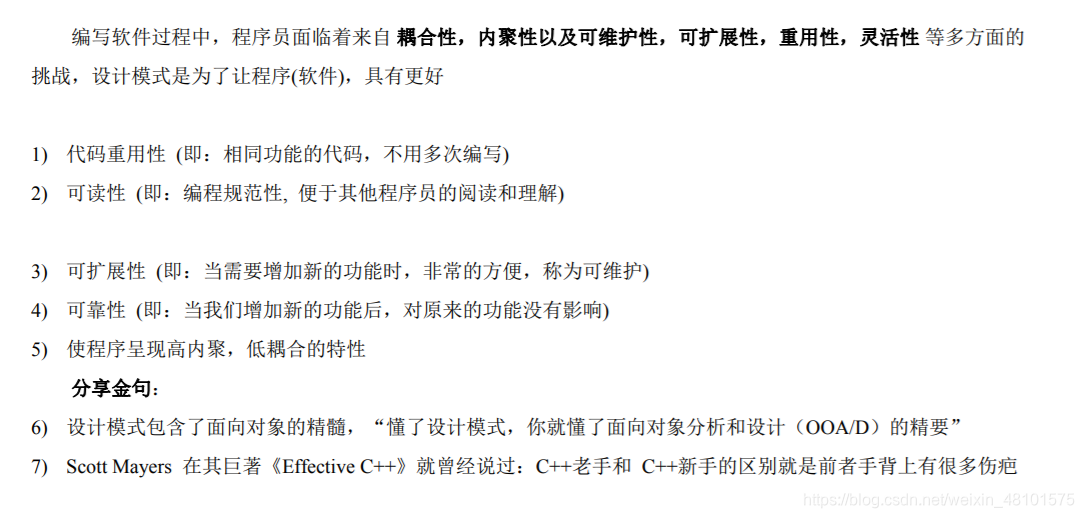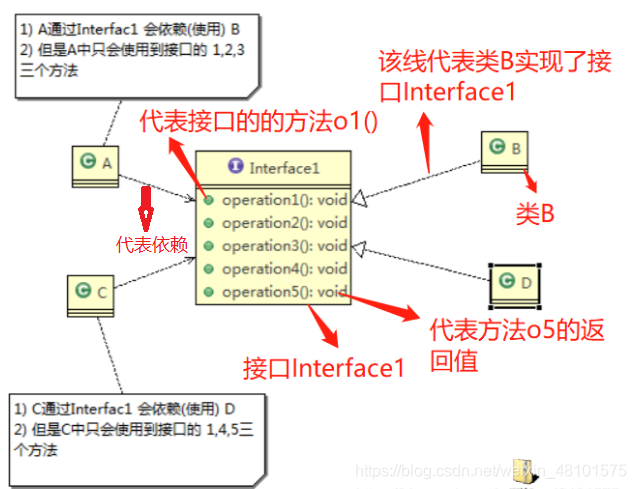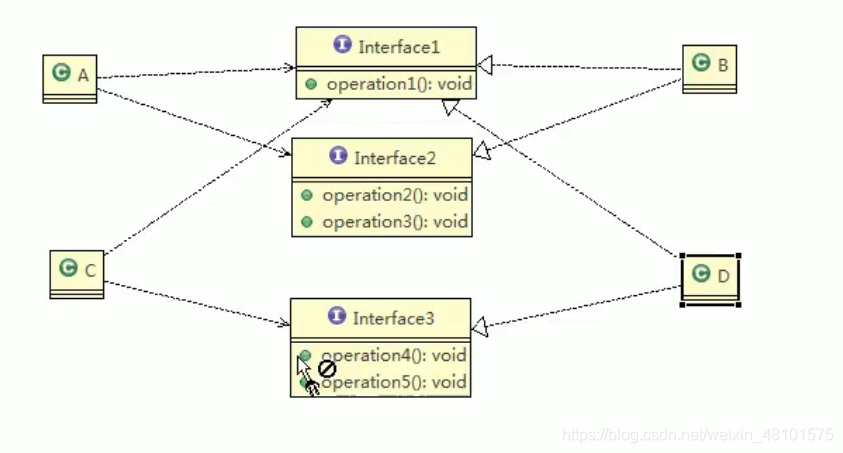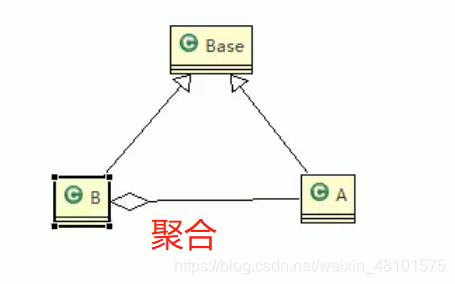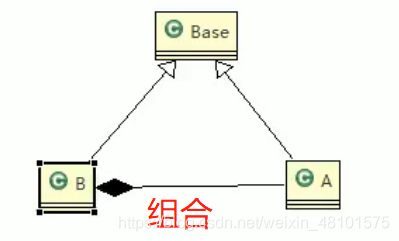大家好,欢迎来到IT知识分享网。
设计模式——尚硅谷笔记
设计模式的目的
设计模式七大原则
1) 单一职责原则(各行其职)
基本介绍
应用实例
交通工具案例
方案一(违反单一职责原则)
package com.atguigu.principle.singleresponsibility; public class SingleResponsibility1 {
public static void main(String[] args) {
// TODO Auto-generated method stub Vehicle vehicle = new Vehicle(); vehicle.run("摩托车"); vehicle.run("汽车"); vehicle.run("飞机"); } } // 交通工具类 // 方式1 // 1. 在方式1 的run方法中,违反了单一职责原则,不能所有交通工具都只能在公路上运行。 // 2. 解决的方案非常的简单,根据交通工具运行方法不同,分解成不同类即可 class Vehicle {
public void run(String vehicle) {
System.out.println(vehicle + " 在公路上运行...."); } } 方案二(类上遵守单一职责原则,成本比较高)
package com.atguigu.principle.singleresponsibility; public class SingleResponsibility2 {
public static void main(String[] args) {
// TODO Auto-generated method stub RoadVehicle roadVehicle = new RoadVehicle(); roadVehicle.run("摩托车"); roadVehicle.run("汽车"); AirVehicle airVehicle = new AirVehicle(); airVehicle.run("飞机"); } } //方案2的分析 //1. 遵守单一职责原则 //2. 但是这样做的改动很大,即将类分解,同时修改客户端(即main方法里边的代码) //3. 改进:直接修改Vehicle 类,改动的代码会比较少=>方案3 class RoadVehicle {
public void run(String vehicle) {
System.out.println(vehicle + "公路运行"); } } class AirVehicle {
public void run(String vehicle) {
System.out.println(vehicle + "天空运行"); } } class WaterVehicle {
public void run(String vehicle) {
System.out.println(vehicle + "水中运行"); } } 方案三(方法上遵守单一职责原则)
package com.atguigu.principle.singleresponsibility; public class SingleResponsibility3 {
public static void main(String[] args) {
// TODO Auto-generated method stub Vehicle2 vehicle2 = new Vehicle2(); vehicle2.run("汽车"); vehicle2.runWater("轮船"); vehicle2.runAir("飞机"); } } //方式3的分析 //1. 这种修改方法没有对原来的类做大的修改,只是增加方法 //2. 这里虽然没有在类这个级别上遵守单一职责原则,但是在方法级别上,仍然是遵守单一职责 class Vehicle2 {
public void run(String vehicle) {
//处理 System.out.println(vehicle + " 在公路上运行...."); } public void runAir(String vehicle) {
System.out.println(vehicle + " 在天空上运行...."); } public void runWater(String vehicle) {
System.out.println(vehicle + " 在水中行...."); } } 单一职责原则注意事项和细节
- 降低类的复杂度,一个类只负责一项职责。
- 提高类的可读性,可维护性
- 降低变更引起的风险
- 通常情况下,我们应当遵守单一职责原则,只有逻辑足够简单,才可以在代码级违
反单一职责原则;只有类中方法数量足够少,可以在方法级别保持单一职责原则(如方案三)
2) 接口隔离原则(Interface Segregation Principle)
基本介绍
- 客户端不应该依赖它不需要的接口,即一个类对另一个类的依赖应该建立在最小的接口上
- UML图解
- 类A通过接口Interface1依赖类B,类C通过接口Interface1依赖类D,如果接口Interface1对于类A和类C来说不是最小接口,那么类B和类D必须去实现他们不需要的方法。
- 按隔离原则应当这样处理:将接口Interface1拆分为独立的几个接口,类A和类C分别与他们需要的接口建立依赖关系。也就是采用接口隔离原则
应用实例
- 类A通过接口Interface1依赖类B,类C通过接口Interface1依赖类D,
代码存在问题:类B,D都实现了Interface1中的所有方法,但是类A,类C分别依赖于B,D只是用到其中的三个方法,其他方法造成资源浪费。
package com.atguigu.principle.segregation; public class Segregation1 {
public static void main(String[] args) {
// TODO Auto-generated method stub } } //接口 interface Interface1 {
void operation1(); void operation2(); void operation3(); void operation4(); void operation5(); } class B implements Interface1 {
public void operation1() {
System.out.println("B 实现了 operation1"); } public void operation2() {
System.out.println("B 实现了 operation2"); } public void operation3() {
System.out.println("B 实现了 operation3"); } public void operation4() {
System.out.println("B 实现了 operation4"); } public void operation5() {
System.out.println("B 实现了 operation5"); } } class D implements Interface1 {
public void operation1() {
System.out.println("D 实现了 operation1"); } public void operation2() {
System.out.println("D 实现了 operation2"); } public void operation3() {
System.out.println("D 实现了 operation3"); } public void operation4() {
System.out.println("D 实现了 operation4"); } public void operation5() {
System.out.println("D 实现了 operation5"); } } class A {
//A 类通过接口Interface1 依赖(使用) B类,但是只会用到1,2,3方法 public void depend1(Interface1 i) {
i.operation1(); } public void depend2(Interface1 i) {
i.operation2(); } public void depend3(Interface1 i) {
i.operation3(); } } class C {
//C 类通过接口Interface1 依赖(使用) D类,但是只会用到1,4,5方法 public void depend1(Interface1 i) {
i.operation1(); } public void depend4(Interface1 i) {
i.operation4(); } public void depend5(Interface1 i) {
i.operation5(); } } - 应传统方法的问题和使用接口隔离原则改进
- 类A通过接口Interface1依赖类B,类C通过接口Interface1依赖类D,如果接口
Interface1对于类A和类C来说不是最小接口,那么类B和类D必须去实现他们不
需要的方法- 将接口Interface1拆分为独立的几个接口,类A和类C分别与他们需要的接口建立
依赖关系。也就是采用接口隔离原则- 接口Interface1中出现的方法,根据实际情况拆分为三个接口
UML图解如下:
代码如下:
package com.atguigu.principle.segregation.improve; public class Segregation1 {
public static void main(String[] args) {
// TODO Auto-generated method stub // 使用一把 A a = new A(); a.depend1(new B()); // A类通过接口去依赖B类 a.depend2(new B()); a.depend3(new B()); C c = new C(); c.depend1(new D()); // C类通过接口去依赖(使用)D类 c.depend4(new D()); c.depend5(new D()); } } // 接口1 interface Interface1 {
void operation1(); } // 接口2 interface Interface2 {
void operation2(); void operation3(); } // 接口3 interface Interface3 {
void operation4(); void operation5(); } class B implements Interface1, Interface2 {
public void operation1() {
System.out.println("B 实现了 operation1"); } public void operation2() {
System.out.println("B 实现了 operation2"); } public void operation3() {
System.out.println("B 实现了 operation3"); } } class D implements Interface1, Interface3 {
public void operation1() {
System.out.println("D 实现了 operation1"); } public void operation4() {
System.out.println("D 实现了 operation4"); } public void operation5() {
System.out.println("D 实现了 operation5"); } } class A {
// A 类通过接口Interface1,Interface2 依赖(使用) B类,但是只会用到1,2,3方法 public void depend1(Interface1 i) {
i.operation1(); } public void depend2(Interface2 i) {
i.operation2(); } public void depend3(Interface2 i) {
i.operation3(); } } class C {
// C 类通过接口Interface1,Interface3 依赖(使用) D类,但是只会用到1,4,5方法 public void depend1(Interface1 i) {
i.operation1(); } public void depend4(Interface3 i) {
i.operation4(); } public void depend5(Interface3 i) {
i.operation5(); } } 3) 依赖倒转原则(Dependence Inversion Principle)
基本介绍
- 高层模块不应该依赖低层模块,二者都应该依赖其抽象
- 抽象不应该依赖细节,细节应该依赖抽象
- 依赖倒转(倒置)的中心思想是面向接口编程
- 依赖倒转原则是基于这样的设计理念:相对于细节的多变性,抽象的东西要稳定的多。以抽象为基础搭建的架构比以细节为基础的架构要稳定的多。在java中,抽象指的是接口或抽象类,细节就是具体的实现类
- 使用接口或抽象类的目的是制定好规范,而不涉及任何具体的操作,把展现细节的任务交给他们的实现类去完成
应用实例
方案一:常规想法
package com.atguigu.principle.inversion; public class DependecyInversion {
public static void main(String[] args) {
Person person = new Person(); person.receive(new Email()); } } class Email {
public String getInfo() {
return "电子邮件信息: hello,world"; } } //完成Person接收消息的功能 //方式1分析 //1. 简单,比较容易想到 //2. 如果我们获取的对象是 微信,短信等等,则新增类,同时Perons也要增加相应的接收方法 //3. 解决思路:引入一个抽象的接口IReceiver, 表示接收者, 这样Person类与接口IReceiver发生依赖 // 因为Email, WeiXin 等等属于接收的范围,他们各自实现IReceiver 接口就ok,这便是细节依赖抽象, 这样我们就符和依赖倒转原则 class Person {
public void receive(Email email ) {
System.out.println(email.getInfo()); } } 方案二:引入一个抽象的接口IReceiver, 表示接收者, 这样Person类与接口IReceiver发生依赖
package com.atguigu.principle.inversion.improve; public class DependecyInversion {
public static void main(String[] args) {
//客户端无需改变 Person person = new Person(); person.receive(new Email()); person.receive(new WeiXin()); } } //定义接口 interface IReceiver {
public String getInfo(); } class Email implements IReceiver {
public String getInfo() {
return "电子邮件信息: hello,world"; } } //增加微信 class WeiXin implements IReceiver {
public String getInfo() {
return "微信信息: hello,ok"; } } //方式2 class Person {
//这里我们是对接口的依赖 public void receive(IReceiver receiver ) {
System.out.println(receiver.getInfo()); } } 依赖关系传递的三种方式和应用案例
- 接口传递
- 构造方法传递
- setter方式传递
package com.atguigu.principle.inversion.improve; public class DependencyPass {
public static void main(String[] args) {
// TODO Auto-generated method stub ChangHong changHong = new ChangHong(); // OpenAndClose openAndClose = new OpenAndClose(); // openAndClose.open(changHong); //通过构造器进行依赖传递 // OpenAndClose openAndClose = new OpenAndClose(changHong); // openAndClose.open(); //通过setter方法进行依赖传递 OpenAndClose openAndClose = new OpenAndClose(); openAndClose.setTv(changHong); openAndClose.open(); } } // 方式1: 通过接口传递实现依赖 // 开关的接口 // interface IOpenAndClose {
// public void open(ITV tv); //抽象方法,接收接口 // } // // interface ITV { //ITV接口 // public void play(); // } // // class ChangHong implements ITV {
// // @Override // public void play() {
// // TODO Auto-generated method stub // System.out.println("长虹电视机,打开"); // } // // } 实现接口 // class OpenAndClose implements IOpenAndClose{
// public void open(ITV tv){
// tv.play(); // } // } // 方式2: 通过构造方法依赖传递 // interface IOpenAndClose {
// public void open(); //抽象方法 // } // interface ITV { //ITV接口 // public void play(); // } // class OpenAndClose implements IOpenAndClose{
// public ITV tv; //成员 // public OpenAndClose(ITV tv){ //构造器 // this.tv = tv; // } // public void open(){
// this.tv.play(); // } // } // 方式3 , 通过setter方法传递 interface IOpenAndClose {
public void open(); // 抽象方法 public void setTv(ITV tv); } interface ITV {
// ITV接口 public void play(); } class OpenAndClose implements IOpenAndClose {
private ITV tv; public void setTv(ITV tv) {
this.tv = tv; } public void open() {
this.tv.play(); } } class ChangHong implements ITV {
@Override public void play() {
// TODO Auto-generated method stub System.out.println("长虹电视机,打开"); } } 依赖倒转原则的注意事项和细节
- 低层模块尽量都要有抽象类或接口,或者两者都有,程序稳定性更好.
- 变量的声明类型尽量是抽象类或接口, 这样我们的变量引用和实际对象间,就存在一个缓冲层,利于程序扩展和优化
- 继承时遵循里氏替换原则
4) 里氏替换原则(Liskov Substitution Principle)
OO中的继承性的思考和说明
- 继承包含这样一层含义:父类中凡是已经实现好的方法,实际上是在设定规范和契
约,虽然它不强制要求所有的子类必须遵循这些契约,但是如果子类对这些已经实
现的方法任意修改,就会对整个继承体系造成破坏。 - 继承在给程序设计带来便利的同时,也带来了弊端。比如使用继承会给程序带来侵
入性,程序的可移植性降低,增加对象间的耦合性,如果一个类被其他的类所继承,
则当这个类需要修改时,必须考虑到所有的子类,并且父类修改后,所有涉及到子
类的功能都有可能产生故障 - 问题提出:在编程中,如何正确的使用继承? => 里氏替换原则
基本介绍
- 如果对每个类型为T1的对象o1,都有类型为T2的对象o2,使得以T1定义的所有程序P在所有的对象o1都代换成o2时,程序P的行为没有发生变化,那么类型T2是类型T1的子类型。换句话说,所有引用基类的地方必须能透明地使用其子类的对象。
- 在使用继承时,遵循里氏替换原则,在子类中尽量不要重写父类的方法
- 里氏替换原则告诉我们,继承实际上让两个类耦合性增强了,在适当的情况下,可以通过聚合,组合,依赖 来解决问题。.
一个程序引出的问题和思考
package com.atguigu.principle.liskov; public class Liskov {
public static void main(String[] args) {
// TODO Auto-generated method stub A a = new A(); System.out.println("11-3=" + a.func1(11, 3)); System.out.println("1-8=" + a.func1(1, 8)); System.out.println("-----------------------"); B b = new B(); System.out.println("11-3=" + b.func1(11, 3));//这里本意是求出11-3 System.out.println("1-8=" + b.func1(1, 8));// 1-8 System.out.println("11+3+9=" + b.func2(11, 3)); } } // A类 class A {
// 返回两个数的差 public int func1(int num1, int num2) {
return num1 - num2; } } // B类继承了A // 增加了一个新功能:完成两个数相加,然后和9求和 class B extends A {
//这里,重写了A类的方法, 可能是无意识 public int func1(int a, int b) {
return a + b; } public int func2(int a, int b) {
return func1(a, b) + 9; } } 解决方法
- 我们发现原来运行正常的相减功能发生了错误。原因就是类B无意中重写了父类的方法,造成原有功能出现错误。在实际编程中,我们常常会通过重写父类的方法完成新的功能,这样写起来虽然简单,但整个继承体系的复用性会比较差。特别是运行多态比较频繁的时候
- 通用的做法是:原来的父类和子类都继承一个更通俗的基类,原有的继承关系去掉,采用依赖,聚合,组合等关系代替.
URL类图转换如下:
代码如下:
package com.atguigu.principle.liskov.improve; public class Liskov {
public static void main(String[] args) {
// TODO Auto-generated method stub A a = new A(); System.out.println("11-3=" + a.func1(11, 3)); System.out.println("1-8=" + a.func1(1, 8)); System.out.println("-----------------------"); B b = new B(); //因为B类不再继承A类,因此调用者,不会再func1是求减法 //调用完成的功能就会很明确 System.out.println("11+3=" + b.func1(11, 3));//这里本意是求出11+3 System.out.println("1+8=" + b.func1(1, 8));// 1+8 System.out.println("11+3+9=" + b.func2(11, 3)); //使用组合仍然可以使用到A类相关方法 System.out.println("11-3=" + b.func3(11, 3));// 这里本意是求出11-3 } } //创建一个更加基础的基类 class Base {
//把更加基础的方法和成员写到Base类 } // A类 class A extends Base {
// 返回两个数的差 public int func1(int num1, int num2) {
return num1 - num2; } } // B类继承了A // 增加了一个新功能:完成两个数相加,然后和9求和 class B extends Base {
//如果B需要使用A类的方法,使用组合关系 private A a = new A(); //这里,重写了A类的方法, 可能是无意识 public int func1(int a, int b) {
return a + b; } public int func2(int a, int b) {
return func1(a, b) + 9; } //我们仍然想使用A的方法 public int func3(int a, int b) {
return this.a.func1(a, b); } } 5) 开闭原则 ocp(最基础,最重要)
基本介绍
- 开闭原则(Open Closed Principle)是编程中最基础、最重要的设计原则
- 一个软件实体如类,模块和函数应该对扩展开放(对提供方),对修改关闭(对使用方)。用抽象构建框架,用实现扩展细节。
- 当软件需要变化时,尽量通过扩展软件实体的行为来实现变化,而不是通过修改已有的代码来实现变化。
- 编程中遵循其它原则,以及使用设计模式的目的就是遵循开闭原则。
类图设计
一个画图形的功能
方案1的优缺点:
- 优点是比较好理解,简单易操作。
- 缺点是违反了设计模式的ocp原则,即对扩展开放(提供方),对修改关闭(使用方)。即当我们给类增加新功能的时候,尽量不修改代码,或者尽可能少修改代码.
- 比如我们这时要新增加一个图形种类 三角形,我们需要做如下修改,修改的地方较多
- 代码演示
package com.atguigu.principle.ocp; public class Ocp {
public static void main(String[] args) {
//使用看看存在的问题 GraphicEditor graphicEditor = new GraphicEditor(); graphicEditor.drawShape(new Rectangle()); graphicEditor.drawShape(new Circle()); graphicEditor.drawShape(new Triangle()); } } //这是一个用于绘图的类 [使用方] class GraphicEditor {
//接收Shape对象,然后根据type,来绘制不同的图形 public void drawShape(Shape s) {
if (s.m_type == 1) drawRectangle(s); else if (s.m_type == 2) drawCircle(s); else if (s.m_type == 3) drawTriangle(s); } //绘制矩形 public void drawRectangle(Shape r) {
System.out.println(" 绘制矩形 "); } //绘制圆形 public void drawCircle(Shape r) {
System.out.println(" 绘制圆形 "); } //绘制三角形 public void drawTriangle(Shape r) {
System.out.println(" 绘制三角形 "); } } //Shape类,基类 class Shape {
int m_type; } class Rectangle extends Shape {
Rectangle() {
super.m_type = 1; } } class Circle extends Shape {
Circle() {
super.m_type = 2; } } //新增画三角形 class Triangle extends Shape {
Triangle() {
super.m_type = 3; } } 方案2:
package com.atguigu.principle.ocp.improve; public class Ocp {
public static void main(String[] args) {
//使用看看存在的问题 GraphicEditor graphicEditor = new GraphicEditor(); graphicEditor.drawShape(new Rectangle()); graphicEditor.drawShape(new Circle()); graphicEditor.drawShape(new Triangle()); graphicEditor.drawShape(new OtherGraphic()); } } //这是一个用于绘图的类 [使用方] class GraphicEditor {
//接收Shape对象,调用draw方法 public void drawShape(Shape s) {
s.draw(); } } //Shape类,基类 abstract class Shape {
int m_type; public abstract void draw();//抽象方法 } class Rectangle extends Shape {
Rectangle() {
super.m_type = 1; } @Override public void draw() {
// TODO Auto-generated method stub System.out.println(" 绘制矩形 "); } } class Circle extends Shape {
Circle() {
super.m_type = 2; } @Override public void draw() {
// TODO Auto-generated method stub System.out.println(" 绘制圆形 "); } } //新增画三角形 class Triangle extends Shape {
Triangle() {
super.m_type = 3; } @Override public void draw() {
// TODO Auto-generated method stub System.out.println(" 绘制三角形 "); } } //新增一个图形 class OtherGraphic extends Shape {
OtherGraphic() {
super.m_type = 4; } @Override public void draw() {
// TODO Auto-generated method stub System.out.println(" 绘制其它图形 "); } } 6) 迪米特法则(Demeter Principle)
基本介绍
- 一个对象应该对其他对象保持最少的了解
- 类与类关系越密切,耦合度越大
- 迪米特法则(Demeter Principle)又叫最少知道原则,即一个类对自己依赖的类知道的越少越好。也就是说,对于被依赖的类不管多么复杂,都尽量将逻辑封装在类的内部。对外除了提供的public 方法,不对外泄露任何信息
- 迪米特法则还有个更简单的定义:只与直接的朋友通信
- 直接的朋友:每个对象都会与其他对象有耦合关系,只要两个对象之间有耦合关系,我们就说这两个对象之间是朋友关系。耦合的方式很多,依赖,关联,组合,聚合等。其中,我们称出现成员变量,方法参数,方法返回值中的类为直接的朋友,而出现在局部变量中的类不是直接的朋友。也就是说,陌生的类最好不要以局部变量的形式出现在类的内部。
应用实例
原始方案:
package com.atguigu.principle.demeter; import java.util.ArrayList; import java.util.List; //客户端 public class Demeter1 {
public static void main(String[] args) {
//创建了一个 SchoolManager 对象 SchoolManager schoolManager = new SchoolManager(); //输出学院的员工id 和 学校总部的员工信息 schoolManager.printAllEmployee(new CollegeManager()); } } //学校总部员工类 class Employee {
private String id; public void setId(String id) {
this.id = id; } public String getId() {
return id; } } //学院的员工类 class CollegeEmployee {
private String id; public void setId(String id) {
this.id = id; } public String getId() {
return id; } } //管理学院员工的管理类 class CollegeManager {
//返回学院的所有员工 public List<CollegeEmployee> getAllEmployee() {
List<CollegeEmployee> list = new ArrayList<CollegeEmployee>(); for (int i = 0; i < 10; i++) {
//这里我们增加了10个员工到 list CollegeEmployee emp = new CollegeEmployee(); emp.setId("学院员工id= " + i); list.add(emp); } return list; } } //学校管理类 //分析 SchoolManager 类的直接朋友类有哪些 Employee、CollegeManager //CollegeEmployee 不是 直接朋友 而是一个陌生类,这样违背了 迪米特法则 class SchoolManager {
//返回学校总部的员工 public List<Employee> getAllEmployee() {
List<Employee> list = new ArrayList<Employee>(); for (int i = 0; i < 5; i++) {
//这里我们增加了5个员工到 list Employee emp = new Employee(); emp.setId("学校总部员工id= " + i); list.add(emp); } return list; } //该方法完成输出学校总部和学院员工信息(id) void printAllEmployee(CollegeManager sub) {
//分析问题 //1. 这里的 CollegeEmployee 不是 SchoolManager的直接朋友 //2. CollegeEmployee 是以局部变量方式出现在 SchoolManager //3. 违反了 迪米特法则 //获取到学院员工 List<CollegeEmployee> list1 = sub.getAllEmployee(); System.out.println("------------学院员工------------"); for (CollegeEmployee e : list1) {
System.out.println(e.getId()); } //获取到学校总部员工 List<Employee> list2 = this.getAllEmployee(); System.out.println("------------学校总部员工------------"); for (Employee e : list2) {
System.out.println(e.getId()); } } } 应用实例改进:
- 前面设计的问题在于SchoolManager中,CollegeEmployee类并不是SchoolManager类的直接朋友 (分析)
- 按照迪米特法则,应该避免类中出现这样非直接朋友关系的耦合
- 对代码按照迪米特法则 进行改进
package com.atguigu.principle.demeter.improve; import java.util.ArrayList; import java.util.List; //客户端 public class Demeter1 {
public static void main(String[] args) {
System.out.println("~~~使用迪米特法则的改进~~~"); //创建了一个 SchoolManager 对象 SchoolManager schoolManager = new SchoolManager(); //输出学院的员工id 和 学校总部的员工信息 schoolManager.printAllEmployee(new CollegeManager()); } } //学校总部员工类 class Employee {
private String id; public void setId(String id) {
this.id = id; } public String getId() {
return id; } } //学院的员工类 class CollegeEmployee {
private String id; public void setId(String id) {
this.id = id; } public String getId() {
return id; } } //管理学院员工的管理类 class CollegeManager {
//返回学院的所有员工 public List<CollegeEmployee> getAllEmployee() {
List<CollegeEmployee> list = new ArrayList<CollegeEmployee>(); for (int i = 0; i < 10; i++) {
//这里我们增加了10个员工到 list CollegeEmployee emp = new CollegeEmployee(); emp.setId("学院员工id= " + i); list.add(emp); } return list; } //输出学院员工的信息 public void printEmployee() {
//获取到学院员工 List<CollegeEmployee> list1 = getAllEmployee(); System.out.println("------------学院员工------------"); for (CollegeEmployee e : list1) {
System.out.println(e.getId()); } } } //学校管理类 //分析 SchoolManager 类的直接朋友类有哪些 Employee、CollegeManager //CollegeEmployee 不是 直接朋友 而是一个陌生类,这样违背了 迪米特法则 class SchoolManager {
//返回学校总部的员工 public List<Employee> getAllEmployee() {
List<Employee> list = new ArrayList<Employee>(); for (int i = 0; i < 5; i++) {
//这里我们增加了5个员工到 list Employee emp = new Employee(); emp.setId("学校总部员工id= " + i); list.add(emp); } return list; } //该方法完成输出学校总部和学院员工信息(id) void printAllEmployee(CollegeManager sub) {
//分析问题 //1. 将输出学院的员工方法,封装到CollegeManager sub.printEmployee(); //获取到学校总部员工 List<Employee> list2 = this.getAllEmployee(); System.out.println("------------学校总部员工------------"); for (Employee e : list2) {
System.out.println(e.getId()); } } } 迪米特法则注意事项和细节
- 迪米特法则的核心是降低类之间的耦合
- 但是注意:由于每个类都减少了不必要的依赖,因此迪米特法则只是要求降低类间(对象间)耦合关系, 并不是要求完全没有依赖关系
7) 合成复用原则(Composite Reuse Principle)
基本介绍
设计原则核心思想
- 找出应用中可能需要变化之处,把它们独立出来,不要和那些不需要变化的代码混在一起。
- 针对接口编程,而不是针对实现编程。
- 为了交互对象之间的松耦合设计而努力
设计模式类型
1、创建型模式
1)单例模式(重点)
2)工厂模式、抽象工厂模式(重点)
3)原型模式
4)建造者模式
2、结构型模式
1)装饰者模式(重点)
2)代理模式(重点)
3)适配器模式
4)桥接模式
5)组合模式
6)外观模式
7)享元模式
3、行为型模式
1)观察者模式(重点)
2)模版方法模式
3)命令模式
4)访问者模式
5)迭代器模式
6)中介者模式
7)备忘录模式
8)解释器模式(Interpreter模式)
9)状态模式
10)策略模式(springIOC采用过)
11)职责链模式(责任链模式)
免责声明:本站所有文章内容,图片,视频等均是来源于用户投稿和互联网及文摘转载整编而成,不代表本站观点,不承担相关法律责任。其著作权各归其原作者或其出版社所有。如发现本站有涉嫌抄袭侵权/违法违规的内容,侵犯到您的权益,请在线联系站长,一经查实,本站将立刻删除。 本文来自网络,若有侵权,请联系删除,如若转载,请注明出处:https://haidsoft.com/133242.html

